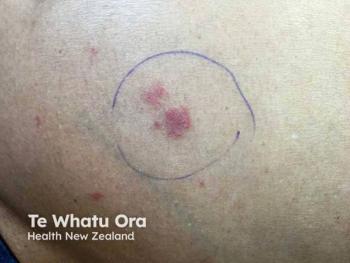
Personalizing Treatment Approaches For Each Unique Patient
Christopher Bunick, MD, PhD, expands on how clinicians can personalize treatment plans for each patient.
Episodes in this series

This news content has been independently developed and is not endorsed by the American Academy of Dermatology.
This Dermatology Times Expert Perspectives series delves into the multifaceted landscape of atopic dermatitis (AD) care and treatment. Through interviews with 4 leading dermatologists, this series explores key benchmarks, emerging trends, personalized medicine approaches, long-term safety considerations, and the integration of novel therapies in the management of AD. Each episode provides valuable insights into navigating the heterogeneity of AD presentations, selecting appropriate treatment plans tailored to individual patient needs, and incorporating the latest guidelines from the American Academy of Dermatology (AAD). From discussing the nuances of patient education and shared decision-making to addressing the intersection of comorbidities with AD management, this series equips dermatology clinicians with the knowledge and strategies necessary to optimize patient outcomes and enhance the quality of care.
In this episode, Christopher Bunick, MD, PhD, of Yale University in New Haven, Connecticut, expands on the current treatment landscape for atopic dermatitis and how clinicians can personalize treatment plans for each patient.
Dermatology Times Interview with Christopher Bunick, MD, PhD
Dermatology Times: What have been the biggest advancements in AD treatment in your time in dermatology?
Bunick: Since I finished residency in 2012, at that time, we really didn't have a lot of great therapies for AD. We relied on traditional immunosuppressants to try to help our AD patients or systemic steroids or lots of topical agents. And it has been amazing over the last decade to watch new therapies come. The first therapy was dupilumab, and it really did change the way and revolutionize how we treat AD patients. And now, we have other biologics like tralokinumab. We have others coming [like] lebrikizumab. We have others in develop development beyond that nimolizumab is on the horizon. So it's been really nice to have a set of biologics to treat these patients.
What we didn't expect in dermatology was the bombshell of small molecules like JAK inhibitors completely take what we thought was the best standard of care for patients and upended and do even better. And that's really been the surprise, I think, over the last 2 to 3 years in dermatology. It has been this entire upheaval of benchmarks, this entire upheaval of what we thought was possible for getting different diseases better and AD is a great example of that, where we're seeing the we're seeing the JAK inhibitors really push that boundary. Now they are complementary to the biologics. And I think that what's really great and in the end, it's all about the patient. And what's really great for the patient is that they have a lot of options. They're pushing the boundary in terms of efficacy. They're pushing the boundary in terms of speed of onset, durability, and even safety.
What we need in dermatology is to have, especially in AD, where it's a very heterogeneous disease. What I mean by that is AD, historically, we've thought about it primarily as an IL-4 or IL-13 mediated disease, but we have learned that it's much more heterogeneous than that. There are other cytokines that definitely play a role, and not every AD patient is the same. This is why we need multiple therapies because there are multiple different types of AD patients and different therapies may work differently in those patients. So having the biologics, having the JAK inhibitors is very helpful. Now, one of the advantages of the JAK inhibitors is it hits multiple cytokine pathways, and I think that explains or ties in these benchmarks that we've been talking about. It ties in these higher efficacy standards and quality of life standards. That's probably why the JAK inhibitors are doing so well is because of their ability to broadly inhibit the cytokines involved in AD pathogenesis. And as they're inhibiting the cytokines, they're doing it within the cell. Right? They're not working outside the cell. They're working inside the cell. And this is important because that's where the JAK stat proteins are being activated to go in and regulate transcriptional machinery. And so this is really, partly why the JAK inhibitors are working really fast is because of that direct action inside the cell.
DT: Outside of systemic therapies, what other treatments (both approved and in the pipeline) are you excited about?
Bunick: There is a place for topical therapies in AD as well, and what we've really learned over the last couple of years is that there's a high demand for nonsteroidal topicals. We've used steroids for a long time, but there's a limit of what you can do in pediatric patients. There's a limit what you can do in adult and adolescent patients. And one of the great things is that we have now a lot of innovation in terms of nonsteroidal topicals. And so for example, we have had for a while, that PDE4 inhibitor, crisaborole, which is out there, and it has helped patients, but we have newer innovation. We have a new generation PDE4 inhibitor that's on the verge of approval roflumilast, for AD. We have a new aryl hydrocarbon agonist, on the verge of approval on AD in tapinarof. We have already approved a JAK inhibitor ruxolitinib for topical use in AD. This is really exciting because these topicals in particular, the one that's approved, ruxolitinib, is really changing the game in treating localized AD disease, because we're able to now use medicines like the JAK inhibitor ruxolitinib that works highly efficaciously, is very quick, and it's comfortable for children and for patients or parents to understand that this is not a steroid. They're more willing to use that type of topical medicine.
We're only going to see the nonsteroidal options increase in the coming months and year and this is, again, a really exciting development for AD patients. The AD patient is unique. Each patient is unique. There is a component of shared medical decision-making that's going to be needed. You have to talk to your patient, understand where they're coming from, and what their need is. We know that AD is a heterogeneous disease. And what we mean by that is the underlying molecular pathophysiology of AD is not the same in every subgroup of patient. So we do have to take into account that variability, that heterogeneity, may mean that different treatments are going to be needed for different patients. For me, I think one of the most important things that I do is I try to get my patients on an advanced therapy early. I asked how much that AD is affecting their quality of life, that connection between skin disease but also how it's affecting them in school, in the workplace, or in their social life. To me that's really important, because it allows me to then communicate with the patient what I think can really be transformative for their AD treatment. I really focus in on the degree of itch, disturbance and the degree of sleep disturbance.
DT: What do you do in those instances?
Bunick: If any of the itch or sleep is high, I really have an honest discussion with my patients about advanced systemic therapies, which at the current moment, involves 2 biologics, dupilumab and tralokinumab, and 2 oral systemic JAK inhibitors, upadacitinib and abrocitinib. And I review those 4 with my patients and there's going to be newer agents coming that's going to make the discussion even more broad. However, at the moment, I have that discussion with my patient. I try to figure out what goals the patient wants from their treatment.
Do they want really fast resolution of their itch and skin? In those cases, the JAK inhibitor might be a great option. Does the patient have concomitant asthma? In that case, dupilumab might be a great option. Has the patient tried a prior biologic or a prior agent and failed that agent? We know that if we know from the past 6, 7 years of lots of patients with severe AD going on dupilumab, that not every patient responds perfectly to that medicine. So how are they biologic naive? Or are they biologic experience? Because if they've tried a biologic and not done as well as they wanted, an oral JAK inhibitor makes a lot of sense. I've also had patients that have failed dupilumab and have done very well with tralokinumab. So there are options out there. But in general, having that desire or understanding of what the patient wants in terms of skin clearance, rapidity of results, and how to get the patient back on their feet and back in their lives quickly, I think that understanding the JAK inhibitors and having a discussion with your patient about them is really important.
Transcript has been edited for clarity.
Newsletter
Like what you’re reading? Subscribe to Dermatology Times for weekly updates on therapies, innovations, and real-world practice tips.























